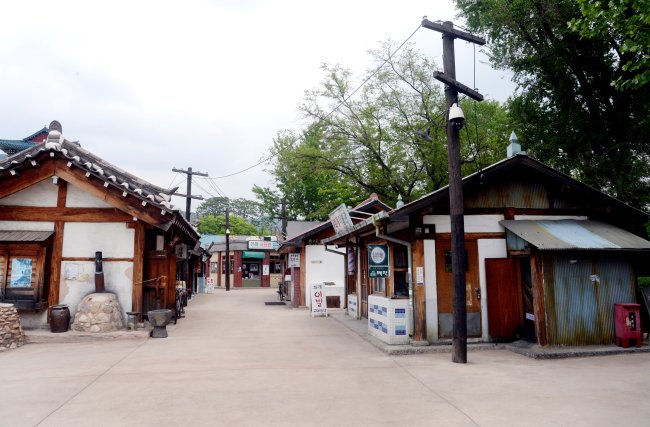“Every memory of looking out the back door/ I had the photo album spread out on my bedroom floor/ It’s hard to say it/ time to say it/ Goodbye, goodbye,” sings the band Nickelback in its 2005 single “Photograph.”
The song was popular in the US and UK, but more than a decade after its release, a disinterested millennial might say to the group’s lead vocalist Chad Kroeger, “What on Earth is a photo album?”
Living in 2017, most people would have to think hard to recollect when he or she last held a physical copy of a photograph, with numerous selfies and pictures for social media usually taken digitally.
As society leaps into the 21st century and new technologies advance, old ways of doing things are rapidly becoming out of use, out of fashion and out of time.

(Park Hyun-koo/The Korea Herald)
Among the things fading away are photo studios. Back when film cameras were predominantly used by the public, people used to take their rolls of film to photo studios to have their pictures developed.
The pictures would be in neat little square or rectangular formats and could be collected in photo albums, allowing photographers to nostalgically spread them out and reminisce on fond memories.
But with the introduction of digital cameras and smartphones leading to the trend of saving photos in digital formats, smaller photo studios gradually declined.
According to the Ministry of Trade, Industry and Energy, the number of local photo studios dropped from around 10,000 in the early 2000s to some 7,600 in 2010.
Director Bong Joon-ho said at a recent press event that he was forced to shoot his film digitally for the first time, as most photographic processing shops had gone out of business.
“I think ‘Snowpiercer’ may be one of the last movies to be shot with film. It’s very sad when you think about it,” he said.
Barber shops are also among those struggling to stay relevant.
For decades, it has been somewhat of an unspoken rule for men to go to barber shops while women and children visit salons. But the trend of male grooming has shifted a considerable number of male customers toward beauty salons.
According to the magazine Economic Review, the number of barber shops here dropped from 24,310 to 18,029 from 2002 to 2012.
Over the same period, the number of public baths and book stores also declined respectively by 27.45 percent and 25.39 percent.
The decrease in the number of book stores, along with that of record shops, stems from the ever-growing trend of digitally downloading books or music.
Men and women poring over pages on the subway is increasingly becoming a rare sight, as the majority of them opt for the convenience of e-books.
KBS Music Bank’s standards for selecting the top song of the week also hints at changing times; digital music sales take up 65 percent of the score while only 5 percent is determined by record sales.
Sipping on a cup of coffee after a meal has become a common practice for Koreans, evidenced by there being twice as many coffee shops in the country than convenience stores, according to the Small Enterprise and Market Service.
But old fashioned tea shops, called “dabangs,” hardly benefit from the trend. It is becoming harder to find such places, though they were so popular in the past for those looking to socialize.
Although the old-fashioned shops have long slipped out of the mainstream, they still have a small group of regulars who visit every now and then.
While they may be obsolete, the sense of nostalgia always brings a pack of old-timers back to places like Eulji Dabang in Eulgijo, Jung-gu.
“There aren’t that many dabang like this anymore. Sitting here, sipping on a cup of coffee makes me very comfortable,” said 60-year-old Kim, a regular at the shop.
By Yoon Min-sik (minsikyoon@heraldcorp.com)






![[Graphic News] More Koreans say they plan long-distance trips this year](http://res.heraldm.com/phpwas/restmb_idxmake.php?idx=645&simg=/content/image/2024/04/17/20240417050828_0.gif&u=)